Clay Fraction Mineralogy and Structural Soil Attributes of Two Soil Classes under the Semi-Arid Climate of Brazil
Abstract
:1. Introduction
2. Materials and Methods
2.1. Study Area and Sample Collection
2.2. Soil Analyses
2.2.1. Physical Analyses and Aggregate Stability
2.2.2. Chemical and Mineralogical Analyses
2.2.3. Mineralogical Analyses
2.3. Statistical Analyses
3. Results
3.1. Physical and Chemical Attributes
3.2. Mineralogical Attributes
3.3. Multivariate Statistical Analysis
4. Discussion
5. Conclusions
Author Contributions
Funding
Institutional Review Board Statement
Informed Consent Statement
Data Availability Statement
Conflicts of Interest
References
- Oliveira, D.P.; Sartor, R.; Souza Júnior, V.S.; Corrêa, M.M.; Romero, E.; Andrade, G.R.P.; Ferreira, T.O. Weathering and clay formation in semi-arid calcareous soils from Northeastern Brazil. Catena 2018, 162, 325–332. [Google Scholar] [CrossRef]
- Ferreira, E.P.; Anjos, L.H.C.; Pereira, M.G.; Valladares, G.S.; Cipriano-Silva, R.; Azevedo, A.C. Genesis and Classification of Soils Containing Carbonate on the Apodi Plateau, Brazil. Rev. Bras. De Ciência Do Solo 2016, 40, e0150036. [Google Scholar] [CrossRef] [Green Version]
- Maranhão, D.D.C.; Pereira, M.G.; Collier, L.S.; Anjos, L.H.C.; Azevedo, A.C.; Cavassani, R.S. Pedogenesis in a karst environment in the Cerrado biome, northern Brazil. Geoderma 2020, 365, 114169. [Google Scholar] [CrossRef]
- Piovesan, E.K.; Bergue, C.T.; Fauth, G.; Viviers, M.C. Palaeoecology of ostracods from the Late Cretaceous from northeastern Brazil and its relation to sequence stratigraphy. Palaeogeogr. Palaeoclimatol. Palaeoecol. 2015, 424, 40–48. [Google Scholar] [CrossRef]
- Bertotti, G.; de Graaf, S.; Bisdom, K.; Oskam, B.B.; Vonhof, H.H.R.; Bezerra, F.J.G.; Reijmer, J.L.; Cazarin, C. Fracturing and fluid-flow during post-rift subsidence in carbonates of the Jandaíra Formation, Potiguar Basin, NE Brazil. Basin Res. 2017, 29, 836–853. [Google Scholar] [CrossRef] [Green Version]
- Silva, O.L.; Bezerra, F.H.R.; Maia, R.P.; Cazarin, C.L. Karst landforms revealed at various scales using LiDAR and UAV in semi-arid Brazil: Consideration on karstification processes and methodological constraints. Geomorphology 2017, 295, 611–630. [Google Scholar] [CrossRef]
- Graaf, S.; Reijmer, J.J.G.; Bertotti, G.V.; Bezerra, F.H.R.; Cazari, C.L.; Bisdom, K.; Vonhof, H.B. Fracturing and calcite cementation controlling fluid flow in the shallow-water carbonates of the Jandaíra Formation, Brazil. Mar. Pet. Geol. 2017, 80, 382–393. [Google Scholar] [CrossRef]
- Oliveira, J.; Manso, C.L.C.; Andrade, E.J. Petalobrissus do cretáceo da Formação Jandaíra. Braz. J. Geol. 2013, 43, 661–672. [Google Scholar] [CrossRef]
- Diaz, N.; Dietrich, F.; Cailleau, G.; Sebag, D.; Ngounou Ngatcha, B.; Verrecchia, E.P. Can mima-like mounds be Vertisol relics (Far North Region of Cameroon, Chad Basin)? Geomorphology 2016, 261, 41–56. [Google Scholar] [CrossRef] [Green Version]
- Ernesto Sobrinho, F. Caracterização, Gênese e Interpretação para uso de Solos Derivados de Calcário da Região da Chapada do Apodi, Rio Grande do Norte. Master’s Thesis, Planting Universidade Federal de Viçosa, Viçosa, Minas Gerais, Brazil, 1979. [Google Scholar]
- Santos, P.G.; Almeida, J.A.; Sequinatto, L. Mineralogy of the Clay Fraction and Chemical Properties of Soils Developed from Sedimentary Lithologies of Pirambóia, Sanga-the-Cabral and Guará Geological Formations in Southern Brazil. Rev. Bras. Ciência Do Solo 2017, 41, e0160344. [Google Scholar] [CrossRef]
- Bortoluzzi, E.C.; Pérez, C.A.S.; Ardisson, J.D.; Tiecher, T.; Caner, L. Occurrence of iron and aluminum sesquioxides and their implications for the P sorption in subtropical soils. Appl. Clay Sci. 2015, 104, 196–204. [Google Scholar] [CrossRef]
- César de Mello, D.; Demattê, J.A.M.; Silvero, N.E.Q.; Di Raimo, L.A.D.L.; Poppiel, R.R.; Mello, F.A.O.; Souza, A.B.; Safanelli, J.L.; Resende, M.E.B.; Rizzo, R. Soil magnetic susceptibility and its relationship with naturally occurring processes and soil attributes in pedosphere, in a tropical environment. Geoderma 2020, 372, 114364. [Google Scholar] [CrossRef]
- Camêlo, D.L.; Ker, J.C.; Fontes, M.P.F.; Corrêa, M.M.; Costa, A.C.S.; Melo, V.F. Pedogenic Iron Oxides in Iron-Rich Oxisols Developed from Mafic Rocks. Rev. Bras. Ciência Do Solo 2017, 41, e0160379. [Google Scholar] [CrossRef]
- Pedrotti, A.; Ferreira, M.M.; Curi, N.; Silva, M.L.N.; Lima, J.M.; Carvalho, R. Relação entre atributos físicos, mineralogia da fração argila e formas de alumínio no solo. Rev. Bras. Ciência Do Solo 2003, 27, 01–09. [Google Scholar] [CrossRef] [Green Version]
- Ghezzehei, T.A.; Or, D. Rheological Properties of Wet Soils and Clays under Steady and Oscillatory Stresses. Soil Sci. Soc. Am. J. 2001, 65, 624–637. [Google Scholar] [CrossRef] [Green Version]
- Intergovernmental Panel on Climate Change (Org.). Summary for Policymakers, in: Climate Change 2013—The Physical Science Basis; Cambridge University Press: Cambridge, UK, 2013; pp. 1–30. [Google Scholar] [CrossRef]
- Gérard, F. Clay minerals, iron/aluminum oxides, and their contribution to phosphate sorption in soils—A myth revisited. Geoderma 2016, 262, 213–226. [Google Scholar] [CrossRef]
- Iavazzo, P.; Adamo, P.; Boni, M.; Hillier, S.; Zampella, M. Mineralogy and chemical forms of lead and zinc in abandoned mine wastes and soils: An example from Morocco. J. Geochemical. Explor. 2012, 113, 56–67. [Google Scholar] [CrossRef]
- Kowalska, J.B.; Skiba, M.; Maj-Szeliga, K.; Mazurek, R.; Zaleski, T. Does calcium carbonate influence clay mineral transformation in soils developed from slope deposits in Southern Poland? J. Soils Sediments 2020, 20, 257–280. [Google Scholar] [CrossRef]
- Andrade, G.R.P.; Furquim, S.A.C.; Nascimento, T.T.V.; Brito, A.C.; Camargo, G.R.; de Souza, G.C. Transformation of clay minerals in salt-affected soils, Pantanal wetland, Brazil. Geoderma 2020, 371, 114380. [Google Scholar] [CrossRef]
- De Sousa, J.E.; dos Santos, J.C.B.; Corrêa, M.M.; do Nascimento, A.F.; Schulze, S.M.B.B.; Ferreira, T.O.; de Araújo Filho, J.C.; de Souza Júnior, V.S. Mineralogy and genesis of Planosols under a semi-arid climate, Borborema Plateau, NE Brazil. CATENA 2020, 184, 104260. [Google Scholar] [CrossRef]
- Omdi, F.E.; Daoudi, L.; Fagel, N. Origin and distribution of clay minerals of soils in semi-arid zones: Example of Ksob watershed (Western High Atlas, Morocco). Appl. Clay Sci. 2018, 163, 81–91. [Google Scholar] [CrossRef]
- Alvares, C.A.; Stape, J.L.; Sentelhas, P.C.; de Moraes Gonçalves, J.L.; Sparovek, G. Köppen’s climate classification map for Brazil. Meteorol. Zeitschrift. 2013, 22, 711–728. [Google Scholar] [CrossRef]
- Santos, H.G.; Jacomine, P.K.T.; Anjos, L.H.C.; Oliveira, V.A.; Lumbreras, J.F.; Coelho, M.R.; Almeida, J.A.; Araújo Filho, J.C.; Oliveira, J.B.; Cunha, T.J.F. Sistema brasileiro de classificação de solos, 5th ed.; Embrapa Solos: Brasília, DF, Brazil, 2018. [Google Scholar]
- World Reference Base (WRB). International Soil Classification System for Naming Soils and Creating Legends for Soil Maps; FAO-Food and Agriculture Organization of the United Nations: Rome, Italy, 2014. [Google Scholar]
- Santos, R.D.; Lemos, R.C.; Santos, H.G.; Ker, J.C.; Anjos, L.H.C. Manual de Descrição e Coleta de Solo No Campo, 7th ed.; SBCS, Sociedade Brasileira de Ciência do Solo: Viçosa, Brazil, 2015; 92p. [Google Scholar]
- Teixeira, P.C.; Donagemma, G.K.; Fontana, A.; Teixeira, W.G. Manual de Métodos de Análise de Solo, 3rd ed.; Embrapa Solos: Brasília, DF, Brazil, 2017. [Google Scholar]
- Kemper, W.D.; Chepil, W.S. Size Distribution of Aggregates. Am. Soc. Agron. 1965, 9, 499–510. [Google Scholar]
- Yoder, R.E. A Direct Method of Aggregate Analysis of Soils and a Study of the Physical Nature of Erosion Losses1. Agron. J. 1936, 28, 337. [Google Scholar] [CrossRef]
- Vettori, L. Métodos de Análise de Solo; Equipe Pedol. e Fertil. do Solo; Ministério da Agric: Rio de Janeiro, Brazil, 1969. [Google Scholar]
- Chen, Y.; Senesi, N.; Schnitzer, M. Information provided on humic substances by E4/E6 ratios. Soil Sci. Soc. Am. J. 1977, 41, 352–358. [Google Scholar] [CrossRef]
- StatSoft, 2004. Statistica Version 7.0.
- Silva, Á.G. Caracterização e Aptidão Agrícola de Solos Representativos do Agropólo Mossoró-Assu. Master’s Thesis, Water and Soil Management. Universidade Federal Rural do Semi-árido, Mossoró, Rio Grande do Norte, Brazil, 2018. [Google Scholar]
- Girão, R.; Moreira, L.J.S.; Girão, A.L.A.; Romero, R.E.; Ferreira, T.O. Soil genesis and iron nodules in a karst environment of the Apodi Plateau. Rev. Ciência Agronômica 2010, 45, 683–695. [Google Scholar] [CrossRef] [Green Version]
- Melfi, A.J.; Pedro, G.; Volkoff, B. Natureza e distribuição dos compostos ferríferos nos solos do Brasil. Rev. Bras. de Ciência do Solo 1979, 3, 47–54. [Google Scholar]
- Anastacio, A.S.; Fabris, J.D.; Stucki Coelho, F.S.; Pinto, I.V.; Viana, J.H.M. Clay fraction mineralogy of a Cambisol in Brazil. Hyperfine Interact. 2006, 166, 619–624. [Google Scholar] [CrossRef]
- Pereira, T.T.C.; Ker, J.C.; Schaefer, C.E.G.R.; Barros, N.F.; Neves, J.C.L.; Almeida, C.C. Gênese de Latossolos e Cambissolos desenvolvidos de rochas pelíticas do grupo Bambuí-Minas Gerais. Rev. Bras. de Ciência do Solo 2010, 34, 1283–1295. [Google Scholar] [CrossRef] [Green Version]
- Ker, J.C. Latossolos do Brasil: Uma revisão. Geonomos 1997, 5, 17–40. [Google Scholar] [CrossRef]
- Mota, J.C.A.; Alves, C.V.O.; Freire, A.G.; Assis Júnior, R.N. Uni and multivariate analyses of soil physical quality indicators of a Cambisol from Apodi Plateau–CE, Brazil. Soil Tillage Res. 2014, 140, 66–73. [Google Scholar] [CrossRef]
- Lu, S.G.; Malik, Z.; Chen, D.P.; Wu, C.F. Porosity and pore size distribution of Ultisols and correlations to soil iron oxides. CATENA 2014, 123, 79–87. [Google Scholar] [CrossRef]
- Durn, G.; Škapin, S.D.; Vdović, N.; Rennert, T.; Ottner, F.; Ružičić, S.; Cukrov, N.; Sondi, I. Impact of iron oxides and soil organic matter on the surface physicochemical properties and aggregation of Terra Rossa and Calcocambisol subsoil horizons from Istria (Croatia). CATENA 2019, 183, 104184. [Google Scholar] [CrossRef]
- Yin, Y.; Wang, L.; Liang, C.; Xi, F.; Pei, Z.; Du, L. Soil Aggregate Stability and Iron and Aluminium Oxide Contents Under Different Fertiliser Treatments in a Long-Term Solar Greenhouse Experiment. Pedosphere 2016, 26, 760–767. [Google Scholar] [CrossRef]
- Mustafa, A.; Minggang, X.; Ali Shah, S.A.; Abrar, M.M.; Nan, S.; Baoren, W.; Zejiang, S.; Naveed, Q.; Mehmood, K.M.; Núñez-Delgado, A. Soil aggregation and soil aggregate stability regulate organic carbon and nitrogen storage in a red soil of southern China. J. Environ. Manag. 2020, 270, 110894. [Google Scholar] [CrossRef]
- Kampf, N.; Dick, D.P. Óxidos de ferro em cambissolos brunos no Rio Grande do Sul e Sul de Minas Gerais. Rev. Bras. de Ciência do Solo 1984, 8, 183–188. [Google Scholar]
- Pötter, R.O.; Kämpf, N. Argilo-minerais e óxidos de ferro em Cambissolos e Latossolos sob regime climático térmico údico no Rio Grande do Sul. Rev. Bras. de Ciência do Solo 1981, 5, 153–159. [Google Scholar]
- Mazurana, M.; Levien, R.; Inda Junior, A.V.; Conte, O.; Bressani, L.A.; Müller, J. Soil susceptibility to compaction under use conditions in southern Brazil. Ciência Agrotecnologia 2017, 41, 60–71. [Google Scholar] [CrossRef] [Green Version]
- Daraghmeh, O.A.; Jensen, J.R.; Petersen, C.T. Soil structure stability under conventional and reduced tillage in a sandy loam. Geoderma 2009, 150, 64–71. [Google Scholar] [CrossRef]
- Acar, M.; Celik, I.; Günal, H. Effects of long-term tillage systems on aggregate-associated organic carbon in the eastern Mediterranean region of Turkey. Eurasian J. Soil Sci. 2018, 7, 51–58. [Google Scholar] [CrossRef] [Green Version]
- He, Y.; Gu, F.; Xu, C.; Wang, Y. Assessing of the influence of organic and inorganic amendments on the physical-chemical properties of a red soil (Ultisol) quality. CATENA 2019, 183, 104231. [Google Scholar] [CrossRef]
- Ran, Y.; Ma, M.; Liu, Y.; Zhou, Y.; Sun, X.; Wu, S.; Huang, P. Hydrological stress regimes regulate effects of binding agents on soil aggregate stability in the riparian zones. Catena 2021, 196, 104815. [Google Scholar] [CrossRef]
- Dao, T.H. Tillage System and Crop Residue Effects on Surface Compaction of a Paleustoll. Agron. J. 1996, 88, 141–148. [Google Scholar] [CrossRef]
- Ju, X.; Jia, Y.; Li, T.; Gao, L.; Gan, M. Morphology and multifractal characteristics of soil pores and their functional implication. CATENA 2021, 196, 104822. [Google Scholar] [CrossRef]
- Sekucia, F.; Dlapa, P.; Kollár, J.; Cerdá, A.; Hrabovský, A.; Svobodová, L. Land-use impact on porosity and water retention of soils rich in rock fragments. CATENA 2020, 195, 104807. [Google Scholar] [CrossRef]
- Guérif, J. Factors influencing compaction-induced increases in soil strength. Soil Tillage Res. 1990, 16, 167–178. [Google Scholar] [CrossRef]
- Muggler, C.C.; Pape, T.; Buurman, P. Laser grain-size determination in soil genetic studies 2. Clay content, clay formation, and aggregation in some brazilian oxisols. Soil Sci. 1997, 162, 219–228. [Google Scholar] [CrossRef]
- Kučera, A.; Skene, K.R.; Kupec, P. Soil hydric properties and carbon stock in a semi-arid region of Iraqi Kurdistan: The importance of historical pedogenesis, climate and locality. Ecol. Indic. 2020, 119, 106813. [Google Scholar] [CrossRef]
- Alori, E.T.; Emmanuel, O.C.; Glick, B.R.; Babalola, O.O. Plant–archaea relationships: A potential means to improve crop production in arid and semi-arid regions. World J. Microbiol. Biotechnol. 2020, 36, 133. [Google Scholar] [CrossRef] [PubMed]
- Xue, J.; Gui, D.; Lei, J.; Su, H.; Zeng, F.; Mao, D.; Jin, Q.; Liu, Y. Oasification: An unable evasive process in fighting against desertification for the sustainable development of arid and semiarid regions of China. CATENA 2019, 179, 197–209. [Google Scholar] [CrossRef]
- Bachman, G.O.; Machette, M.N. Calcic Soils and Calcretes in the Southwestern United States; US Geological Survey: Reston, VA, USA, 1977. [Google Scholar]
- Schwertmann, U.; Taylor, R. Minerals in Soil Environments; Dixon, J.B., Weed, S.B., Eds.; Soil Science Society of America: Madison, WI, USA, 1989. [Google Scholar]
- Celi, L.; Prati, M.; Magnacca, G.; Santoro, V.; Martin, M. Role of crystalline iron oxides on stabilization of inositol phosphates in soil. Geoderma 2020, 374, 114442. [Google Scholar] [CrossRef]
- Vendrame, P.R.S.; Marchão, R.; Brunet, D.; Becquer, T. The potential of NIR spectroscopy to predict soil texture and mineralogy in Cerrado Latosols. Eur. J. Soil Sci. 2012, 63, 743–753. [Google Scholar] [CrossRef]
- Blume, H.P.; Schwertmann, U. Genetic evaluation of profile distribution of aluminium, iron, and manganese oxides. Soil Sci. Soc. Am. Proc. 1969, 33, 438–444. [Google Scholar] [CrossRef]
- Silva, L.S.; Marques Júnior, J.; Barrón, V.; Gomes, R.P.; Teixeira, D.D.B.; Siqueira, D.S.; Vasconcelos, V. Spatial variability of iron oxides in soils from Brazilian sandstone and basalt. CATENA 2020, 185, 104258. [Google Scholar] [CrossRef]
- Corrêa, M.M.; Ker, J.C.; Mendonça, E.S.; Ruiz, H.A.; Bastos, R.S. Atributos físicos, químicos e mineralógicos de solos da região das Várzeas de Sousa (PB). Rev. Bras. Ciência Do Solo 2003, 27, 311–324. [Google Scholar] [CrossRef] [Green Version]
- Oliveira, L.B.; Fontes, M.P.F.; Ribeiro, M.R.; Ker, J.C. Morfologia e classificação de Luvissolos e Planossolos desenvolvidos de rochas metamórficas no semiárido do nordeste brasileiro. Rev. Bras. Ciência Do Solo 2009, 33, 1333–1345. [Google Scholar] [CrossRef] [Green Version]
- Dill, H.G. Residual clay deposits on basement rocks: The impact of climate and the geological setting on supergene argillitization in the Bohemian Massif (Central Europe) and across the globe. Earth-Sci. Rev. 2017, 165, 1–58. [Google Scholar] [CrossRef]
- Kämpf, N.; Curi, N. Pedologia: Fundamentos; Sociedade Brasileira de Ciência do Solo: Viçosa, MG, Brazil, 2012; pp. 207–302. [Google Scholar]
- Mathian, M.; Bueno, G.; Balan, E.; Fritsch, E.; Nascimento, N.R.; Selo, M.; Allard, T. Kaolinite dating from Acrisol and Ferralsol: A new key to understanding the landscape evolution in NW Amazonia (Brazil). Geoderma 2020, 370, 114354. [Google Scholar] [CrossRef]
- Resende, M. Nordeste: Ambiente Agrícolas, Problemas e Sugestões de Pesquisa; Coleção Mossoroense, Série A, n. XXIX; Embrapa: Mossoró, Brazil, 1989. [Google Scholar]
- Lemos, M.S.S.; Curi, N.; Marques, J.J.G.S.M.; Ernesto Sobrinho, F. Evaluation of characteristics of Cambisols derived from limestone in low tablelands in northeastern Brazil: Implications for management. Pesq. Agropec. Bras. 1997, 32, 825–834. [Google Scholar]
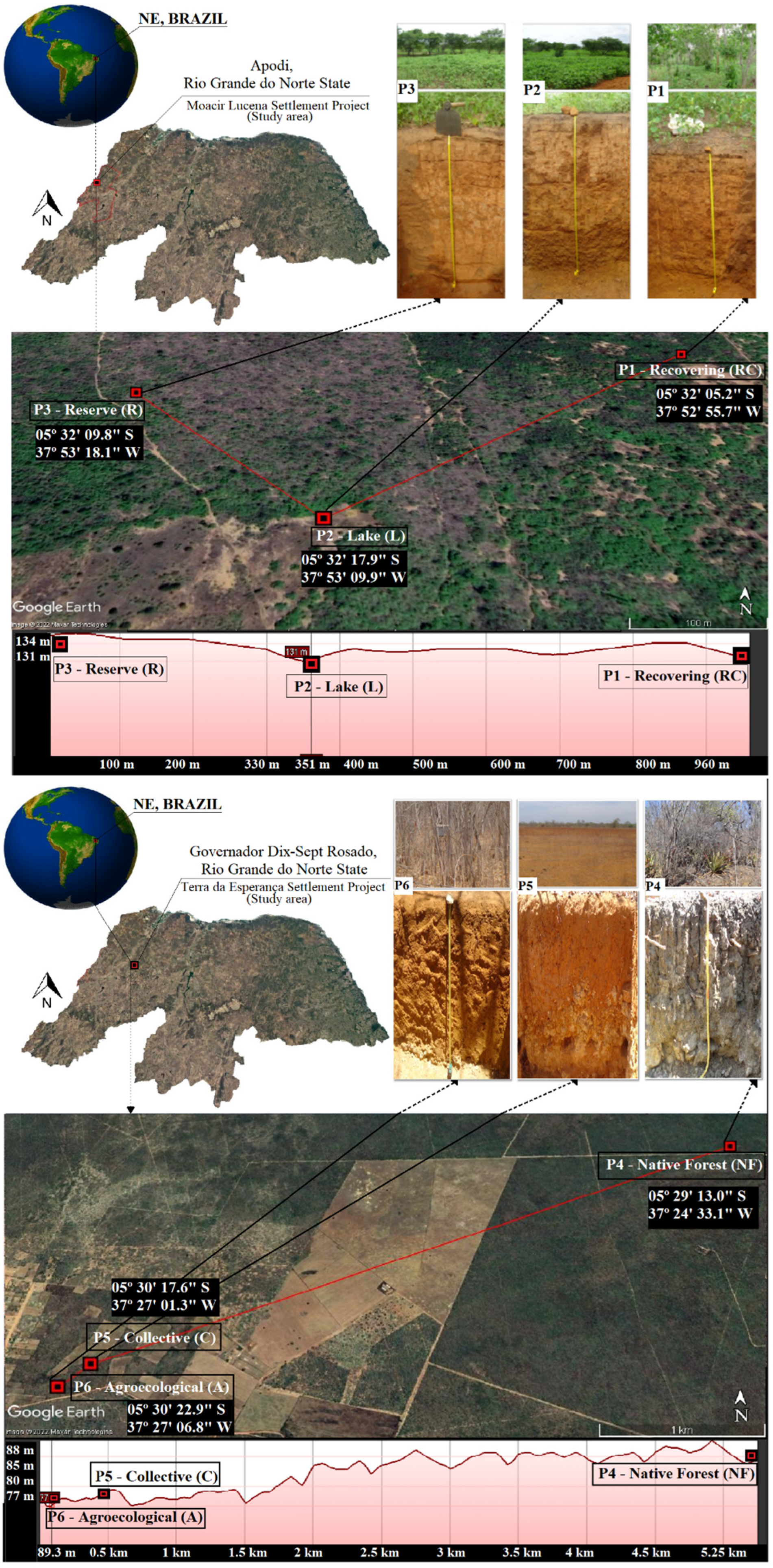
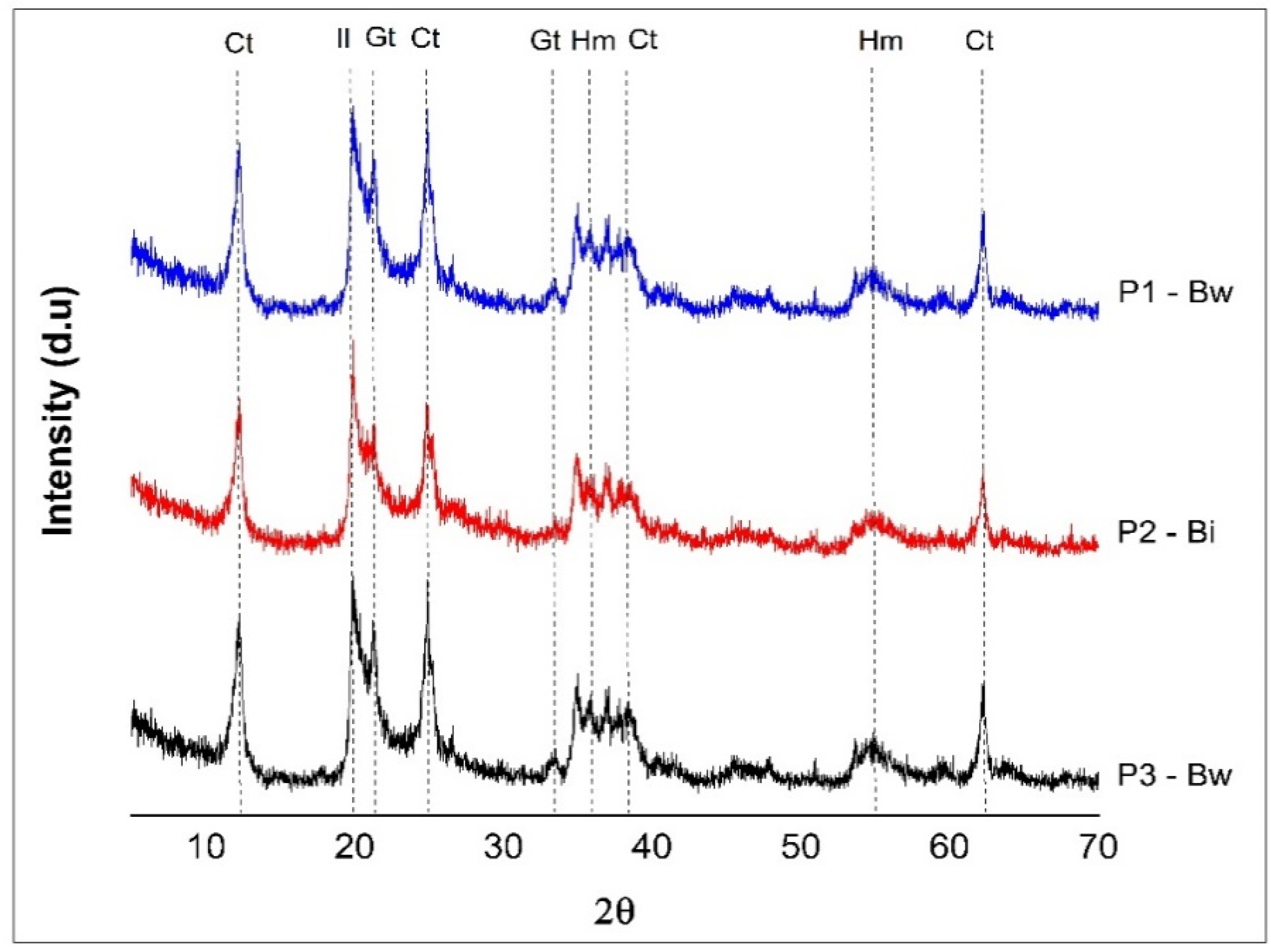

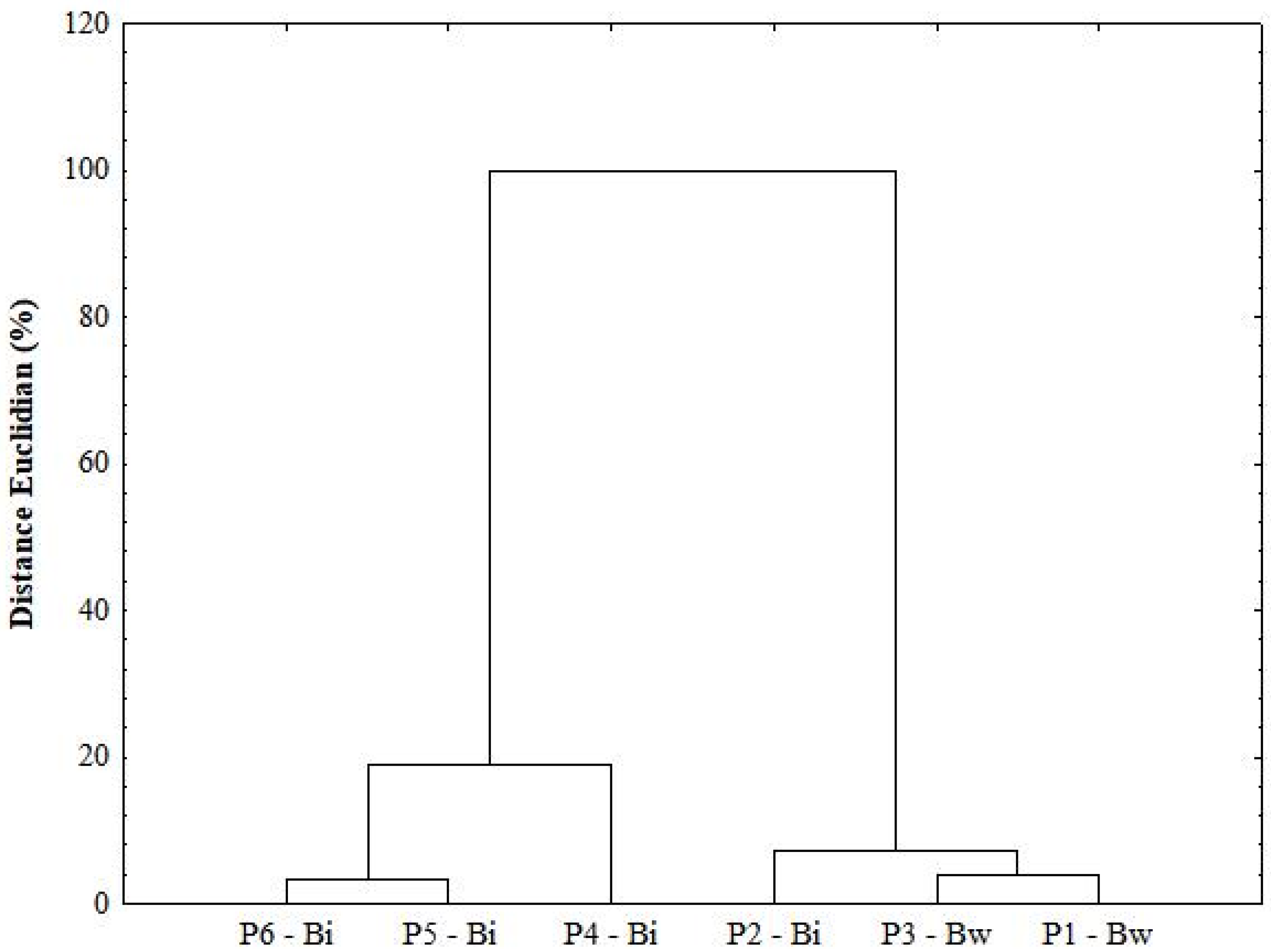
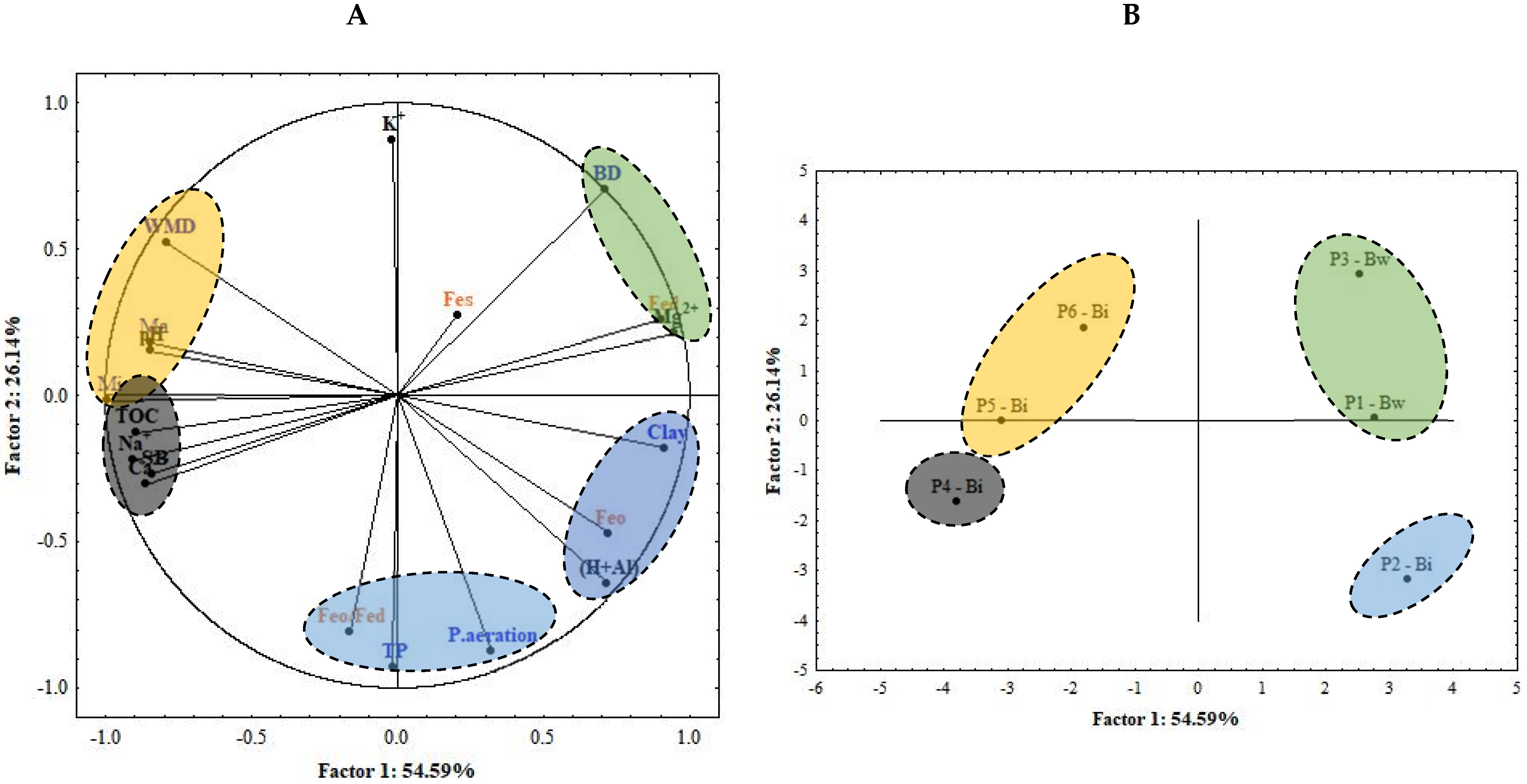
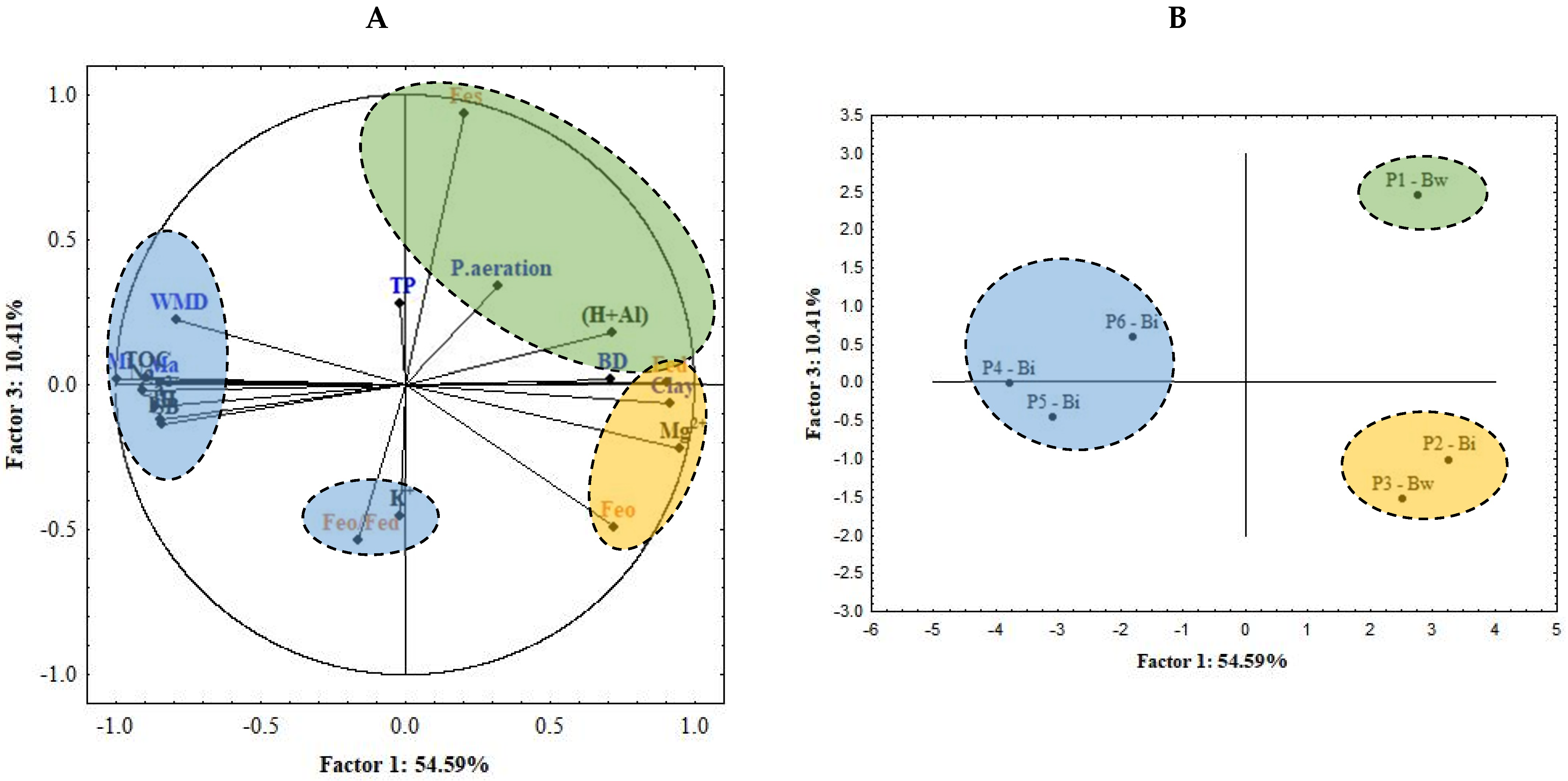
| Profile | Horizont (m) | Soil Class/WRB | Land Use | Settlement |
|---|---|---|---|---|
| P1 | Bw (0.48–1.20) | Ferralsol | Recovering—RC | Moacir Lucena |
| P2 | Bi (0.15–0.54) | Haplic Cambisol | Lake—L | |
| P3 | Bw (0.25–0.97) | Ferralsol | Reserve—R | |
| P4 | Bi (0.08–0.37) | Haplic Cambisol | Native Forest—NF | Terra da Esperança |
| P5 | Bi (0.07–0.22) | Haplic Cambisol | Colective—CC | |
| P6 | Bi (0.10–0.42) | Haplic Cambisol | Agroecological—A |
| Physical Attributes | Unity | Method |
|---|---|---|
| Sand Total (2–0.05 mm) | g.kg−1 | Screening |
| Clay (<0.002 mm) | g.kg−1 | Sedimentation |
| Silt (0.05–0.002 mm) | g.kg−1 | Sedimentation |
| BD | kg.dm−3 | Volumetric ring |
| Mi 1 | cm3.cm−3 | Tension table |
| TP 2 | cm3.cm−3 | Tension table |
| Paeration | cm3.cm−3 | Tension table |
| Ma | cm3.cm−3 | Macroporosity = (TP − Microporosity) |
| WMD | mm | [29] |
| Chemical Attributes | Unity | Method |
|---|---|---|
| TOC | g.kg−1 | Digestion of organic matter 1. |
| pH Calcium (Ca2+) | mg.dm−3 | Agitation of a soil-water suspension (1:5) for 2 h Titrometry 2. |
| Sodium (Na+) Magnesium (Mg2+) Potassium (K+) Potential acidity (H + Al) | mg.dm−3 mg.dm−3 mg.dm−3 | Titrometry 2. Titrometry 2. Titrometry 2. calcium acetate 0.5 mol L−1 |
| Fes | g.kg−1 | Atomic Absorption Spectrophotometry, with a sulfuric attack. |
| Fed | g.kg−1 | Atomic Absorption Spectrophotometry, using Dithionite-Citrate-Bicarbonate. |
| Feo | g.kg−1 | Atomic Absorption Spectrophotometry, using ammonium oxalate. |
| Horizontes (cm) | Sand | Silt | Clay | BD | Mi | Ma | TP | PA | WMD | pH | TOC | P | K | Na | Ca | Mg | SB | V% | H+Al |
|---|---|---|---|---|---|---|---|---|---|---|---|---|---|---|---|---|---|---|---|
| g kg−1 | g cm3 | cm3 cm3 | (%) | mm | g kg−1 | mg kg−1 | cmolc kg | ||||||||||||
| Profile 1—Ferralsol | |||||||||||||||||||
| A (0–4) | 660 | 87 | 253 | 1.60 | 0.27 | 0.14 | 0.41 | 9.40 | 0.94 | 7.24 | 4.80 | 7.19 | 0.47 | 0.03 | 4.30 | 3.80 | 8.60 | 81.47 | 1.96 |
| AB (4–17) | 492 | 92 | 416 | 1.61 | 0.39 | 0.04 | 0.43 | 15.30 | 0.96 | 6.68 | 3.73 | 2.56 | 0.31 | 0.03 | 3.10 | 3.10 | 6.54 | 71.12 | 2.66 |
| BA (17–48) | 371 | 81 | 548 | 1.85 | 0.20 | 0.13 | 0.33 | 10.50 | 0.98 | 6.28 | 7.84 | 2.67 | 0.10 | 0.04 | 3.30 | 2.60 | 6.04 | 71.29 | 2.43 |
| Bw (48–120) | 397 | 97 | 506 | 1.51 | 0.38 | 0.03 | 0.41 | 12.50 | 0.94 | 6.80 | 4.93 | 2.88 | 0.05 | 0.03 | 3.40 | 3.00 | 6.48 | 82.26 | 1.40 |
| BC (120–155+) | 382 | 148 | 470 | 1.60 | 0.39 | 0.05 | 0.44 | 14.10 | 1.95 | 6.58 | 1.77 | 2.25 | 0.05 | 0.02 | 2.50 | 3.80 | 6.37 | 82.90 | 1.31 |
| Profile 2—Cambissol | |||||||||||||||||||
| A (0–3) | 653 | 96 | 251 | 0.72 | 0.30 | 0.07 | 0.37 | 15.20 | 1.85 | 7.64 | 6.23 | 4.56 | 0.42 | 0.08 | 7.10 | 3.30 | 10.90 | 89.65 | 1.26 |
| BA (3–15) | 415 | 135 | 450 | 1.16 | 0.20 | 0.21 | 0.41 | 21.10 | 1.89 | 6.75 | 3.20 | 2.14 | 0.32 | 0.04 | 4.90 | 3.30 | 8.56 | 79.74 | 2.17 |
| Bi (15–54) | 311 | 153 | 536 | 1.37 | 0.41 | 0.03 | 0.44 | 27.40 | 1.96 | 6.51 | 3.54 | 2.14 | 0.05 | 0.03 | 6.40 | 3.40 | 9.88 | 81.93 | 2.18 |
| BC (54–75) | 179 | 230 | 591 | 1.29 | 0.47 | 0.02 | 0.49 | 23.70 | 1.99 | 7.10 | 2.95 | 3.09 | 0.04 | 0.06 | 13.40 | 6.20 | 19.70 | 91.78 | 1.77 |
| C (75–85+) | 322 | 137 | 541 | 1.39 | 0.45 | 0.03 | 0.48 | 19.50 | 7.21 | 1.58 | 7.82 | 0.04 | 0.16 | 20.10 | 8.50 | 28.80 | 99.54 | 0.13 | |
| Profile 3—Ferralsol | |||||||||||||||||||
| A (0–7) | 656 | 57 | 287 | 1.67 | 0.28 | 0.08 | 0.36 | 22.21 | 0.81 | 7.30 | 7.83 | 2.88 | 0.37 | 0.0 | 3.30 | 3.00 | 6.69 | 85.05 | 1.18 |
| BA (7–25) | 556 | 37 | 407 | 1.72 | 0.29 | 0.08 | 0.37 | 21.10 | 0.99 | 6.51 | 4.38 | 1.09 | 0.21 | 0.0 | 4.10 | 0.70 | 5.04 | 75.96 | 1.6 |
| Bw (25–97) | 444 | 44 | 512 | 1.62 | 0.35 | 0.09 | 0.44 | 20.00 | 0.99 | 6.33 | 4.38 | 2.56 | 0.13 | 0.0 | 4.60 | 0.30 | 5.06 | 77.92 | 1.44 |
| BC (97–140+) | 479 | 49 | 472 | 1.58 | 0.37 | 0.05 | 0.42 | 19.85 | 1.02 | 6.93 | 2.19 | 1.40 | 0.10 | 0.0 | 4.30 | 1.00 | 5.43 | 83.81 | 1.05 |
| Profile 4—Cambissol | |||||||||||||||||||
| A (0–8) | 489 | 174 | 337 | 0.96 | 0.53 | 0.08 | 0.61 | 27.32 | 1.76 | 7.06 | 32.10 | 1.50 | 1.15 | 0.28 | 24.30 | 0.15 | 25.88 | 100 | 0.00 |
| Bi (8–37) | 537 | 97 | 366 | 1.23 | 0.47 | 0.08 | 0.55 | 23.32 | 1.19 | 7.64 | 9.19 | 1.50 | 0.23 | 0.41 | 32.30 | 0.70 | 33.64 | 100 | 0.00 |
| C (37–52) | 642 | 106 | 252 | 1.31 | 0.38 | 0.08 | 0.46 | 18.89 | 1.36 | 8.58 | 5.81 | 2.50 | 0.21 | 0.32 | 24.80 | 3.70 | 29.03 | 100 | 0.00 |
| R (52+) | - | - | - | - | - | - | - | - | - | - | - | - | - | - | - | - | |||
| Profile 5—Cambissol | |||||||||||||||||||
| A (0–7) | 673 | 94 | 233 | 1.32 | 0.43 | 0.02 | 0.45 | 22.84 | 1.56 | 8.15 | 48.35 | 3.70 | 2.30 | 0.16 | 17.80 | 0.60 | 20.86 | 100 | 0.00 |
| Bi (7–25) | 569 | 151 | 281 | 1.35 | 0.42 | 0.06 | 0.48 | 21.16 | 1.18 | 8.48 | 9.18 | 0.90 | 0.41 | 0.21 | 15.80 | 1.30 | 17.72 | 100 | 0.00 |
| Bi/C (25–50) | 560 | 170 | 270 | 1.39 | 0.41 | 0.06 | 0.47 | 20.39 | 1.21 | 8.52 | 8.52 | 1.90 | 0.25 | 0.20 | 17.30 | 1.40 | 19.15 | 100 | 0.00 |
| CB (50–200+) | 536 | 182 | 282 | 1.42 | 0.43 | 0.03 | 0.46 | 21.15 | 1.49 | 8.48 | 5.00 | 2.50 | 0.18 | 0.21 | 15.80 | 1.20 | 17.39 | 100 | 0.00 |
| Profile 6—Cambissol | |||||||||||||||||||
| A (0–4) | 691 | 90 | 219 | 1.53 | 0.37 | 0.02 | 0.39 | 18.55 | 1.84 | 7.72 | 20.34 | 2.20 | 1.92 | 0.16 | 15.80 | 5.70 | 23.58 | 100 | 0.00 |
| BA (4–10) | 679 | 77 | 244 | 1.59 | 0.39 | 0.03 | 0.42 | 19.21 | 1.95 | 7.60 | 15.86 | 5.08 | 0.07 | 0.05 | 9.43 | 2.46 | 12.01 | 100 | 0.00 |
| Bi (10–42) | 587 | 115 | 298 | 1.48 | 0.40 | 0.03 | 0.43 | 19.69 | 1.44 | 7.29 | 5.27 | 3.40 | 0.84 | 0.15 | 12.30 | 1.60 | 14.89 | 100 | 0.00 |
| BiC (42–70) | 539 | 206 | 255 | 1.49 | 0.41 | 0.05 | 0.46 | 19.68 | 1.44 | 7.50 | 3.91 | 2.59 | 0.27 | 0.05 | 12.13 | 2.02 | 14.47 | 100 | 0.00 |
| CB (70–76) | 519 | 207 | 274 | - | 0.41 | 0.06 | 0.47 | 19.47 | 1.28 | 7.40 | 3.59 | 0.90 | 0.15 | 0.06 | 14.47 | 1.91 | 16.59 | 100 | 0.00 |
| C (76–91+) | 674 | 63 | 264 | - | 0.41 | 0.06 | 0.47 | 19.49 | 0.84 | 7.84 | 0.95 | 4.70 | 0.53 | 0.16 | 13.30 | 5.00 | 18.99 | 100 | 0.00 |
| Profile/Horizont | Fes | Fed | Feo | Feo/Fed | Clay |
|---|---|---|---|---|---|
| g/kg | |||||
| P1—Bw (Ferralsol) | 13.31 | 2.89 | 0.54 | 0.19 | 506 |
| P2—Bi (Cambisol) | 7.81 | 2.08 | 1.65 | 0.79 | 536 |
| P3—Bw (Ferralsol) | 8.82 | 3.25 | 0.90 | 0.28 | 512 |
| P4—Bi (Cambisol) | 8.96 | 0.62 | 0.36 | 0.57 | 366 |
| P5—Bi (Cambisol) | 8.64 | 0.75 | 0.43 | 0.58 | 281 |
| P6—Bi (Cambisol) | 10.36 | 0.75 | 0.21 | 0.28 | 298 |
| Atributes | Clay | Fes | Fed | Feo | Feo/Fed | TP | P.A | BD | WMD | Mi | Ma | Na+ | Ca2+ | Mg2+ | K+ | SB | (H+Al) | pH |
|---|---|---|---|---|---|---|---|---|---|---|---|---|---|---|---|---|---|---|
| Fes | 0.10 | |||||||||||||||||
| Fed | 0.88 | 0.29 | ||||||||||||||||
| Feo | 0.75 | −0.45 | 0.51 | |||||||||||||||
| Feo/Fed | −0.02 | −0.77 | −0.39 | 0.55 | ||||||||||||||
| TP | 0.06 | −0.02 | −0.33 | 0.32 | 0.64 | |||||||||||||
| P.A. | 0.47 | 0.15 | 0.10 | 0.48 | 0.46 | 0.88 | ||||||||||||
| BD | 0.53 | 0.36 | 0.84 | 0.17 | −0.69 | −0.67 | −0.38 | |||||||||||
| WMD | −0.87 | 0.17 | −0.65 | −0.91 | −0.41 | −0.37 | −0.65 | −0.21 | ||||||||||
| Mi | −0.93 | −0.20 | −0.94 | −0.71 | 0.17 | 0.06 | −0.31 | −0.73 | 0.80 | |||||||||
| Ma | −0.98 | −0.16 | −0.84 | −0.65 | 0.07 | −0.04 | −0.47 | −0.48 | 0.79 | 0.86 | ||||||||
| Na+ | −0.66 | −0.24 | −0.79 | −0.57 | 0.27 | 0.14 | −0.07 | −0.80 | 0.57 | 0.88 | 0.54 | |||||||
| Ca2+ | −0.60 | −0.31 | −0.78 | −0.47 | 0.36 | 0.20 | 0.00 | −0.83 | 0.49 | 0.84 | 0.47 | 0.99 | ||||||
| Mg2+ | 0.86 | 0.05 | 0.94 | 0.69 | −0.21 | −0.28 | 0.05 | 0.82 | −0.70 | −0.96 | −0.78 | −0.89 | −0.86 | |||||
| K+ | −0.13 | −0.19 | 0.18 | −0.20 | −0.47 | −0.93 | −0.93 | 0.58 | 0.40 | 0.01 | 0.14 | −0.15 | −0.18 | 0.26 | ||||
| SB | −0.56 | −0.35 | −0.74 | −0.45 | 0.35 | 0.14 | −0.04 | −0.79 | 0.48 | 0.81 | 0.43 | 0.98 | 1.00 | −0.81 | −0.12 | |||
| (H+Al) | 0.70 | 0.12 | 0.43 | 0.76 | 0.34 | 0.68 | 0.84 | 0.06 | −0.83 | −0.68 | −0.63 | −0.58 | −0.50 | 0.50 | −0.66 | −0.53 | 1.00 | |
| pH | −0.84 | −0.23 | −0.67 | −0.62 | 0.12 | −0.16 | −0.45 | −0.47 | 0.62 | 0.79 | 0.83 | 0.66 | 0.58 | −0.72 | 0.11 | 0.56 | −0.72 | 1.00 |
| TOC | −0.74 | −0.16 | −0.72 | −0.62 | 0.22 | 0.07 | −0.14 | −0.70 | 0.54 | 0.84 | 0.66 | 0.88 | 0.83 | −0.85 | −0.17 | 0.81 | −0.60 | 0.89 |
| Atributes | Factor 1 | Factor 2 | Factor 3 |
|---|---|---|---|
| Clay | −0.90 | 0.23 | −0.07 |
| Fes | −0.22 | −0.26 | 0.94 |
| Fed | −0.92 | −0.21 | 0.01 |
| Feo | −0.70 | 0.51 | −0.49 |
| Feo/Fed | 0.20 | 0.80 | −0.54 |
| TP | 0.06 | 0.93 | 0.28 |
| P. aeration | −0.28 | 0.89 | 0.34 |
| BD | −0.75 | −0.66 | 0.02 |
| WMD | 0.76 | −0.56 | 0.22 |
| Mi | 0.99 | −0.03 | 0.02 |
| Ma | 0.83 | −0.22 | 0.01 |
| Na+ | 0.91 | 0.18 | −0.02 |
| Ca2+ | 0.87 | 0.26 | −0.08 |
| Mg2+ | −0.96 | −0.16 | −0.22 |
| K+ | −0.03 | −0.87 | −0.45 |
| SB | 0.85 | 0.23 | −0.14 |
| (H+Al) | −0.68 | 0.68 | 0.18 |
| pH | 0.84 | −0.19 | −0.12 |
| TOC | 0.90 | 0.08 | 0.02 |
| Eigenvalues | 10.37 | 4.97 | 1.98 |
| Total Variance (%) | 54.59 | 26.14 | 10.41 |
| Accumulated Total Variance (%) | 54.59 | 80.73 | 91.14 |
Publisher’s Note: MDPI stays neutral with regard to jurisdictional claims in published maps and institutional affiliations. |
© 2022 by the authors. Licensee MDPI, Basel, Switzerland. This article is an open access article distributed under the terms and conditions of the Creative Commons Attribution (CC BY) license (https://creativecommons.org/licenses/by/4.0/).
Share and Cite
Lopes, T.C.d.S.; Portela, J.C.; Batista, R.O.; Bandeira, D.J.d.C.; Leite, I.d.O.; Ramalho, L.B.; Gondim, J.E.F.; Costa, J.D.d.; Gurgel, M.T.; Souza, C.M.M.; et al. Clay Fraction Mineralogy and Structural Soil Attributes of Two Soil Classes under the Semi-Arid Climate of Brazil. Land 2022, 11, 2192. https://doi.org/10.3390/land11122192
Lopes TCdS, Portela JC, Batista RO, Bandeira DJdC, Leite IdO, Ramalho LB, Gondim JEF, Costa JDd, Gurgel MT, Souza CMM, et al. Clay Fraction Mineralogy and Structural Soil Attributes of Two Soil Classes under the Semi-Arid Climate of Brazil. Land. 2022; 11(12):2192. https://doi.org/10.3390/land11122192
Chicago/Turabian StyleLopes, Thaís Cristina de Souza, Jeane Cruz Portela, Rafael Oliveira Batista, Diego José da Costa Bandeira, Isaque de Oliveira Leite, Luirla Bento Ramalho, Joaquim Emanuel Fernandes Gondim, Joseane Dunga da Costa, Marcelo Tavares Gurgel, Carolina Malala Martins Souza, and et al. 2022. "Clay Fraction Mineralogy and Structural Soil Attributes of Two Soil Classes under the Semi-Arid Climate of Brazil" Land 11, no. 12: 2192. https://doi.org/10.3390/land11122192





